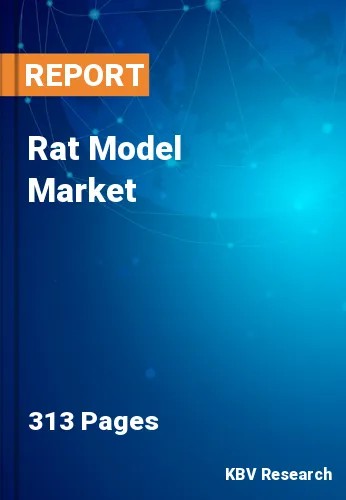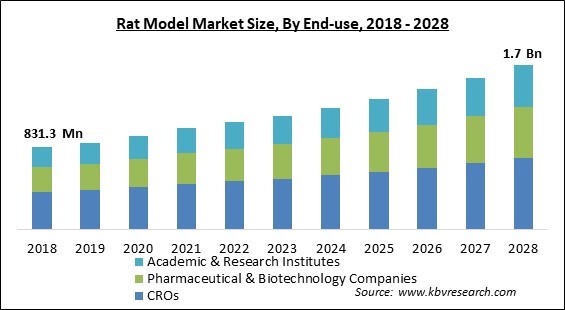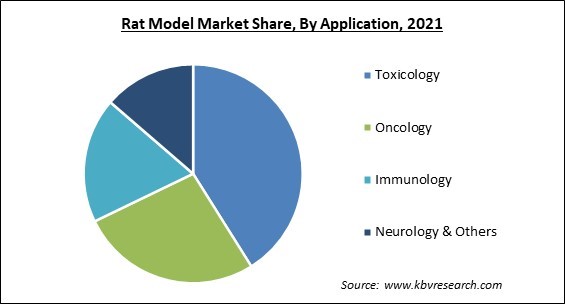
The Global Rat Model Market size is expected to reach $1.7 billion by 2028, rising at a market growth of 7.4% CAGR during the forecast period.
A rat model for human behavior offers evidence of biological evolution against the under-expression of genes associated with aggressiveness in humans. Aggressiveness is an inherited behavioral characteristic that influences an individual's social rank and, consequently, quality and length of life. Therefore, genome-wide research on human aggression is essential. However, the aggressiveness-related genome-wide investigations have only been conducted on animals, not people. The rat has a bigger brain and a more sophisticated behavioral repertoire but retains many tractable traits that make it suited to laboratory research.

Rats are the first mammalian species domesticated expressly for laboratory purposes. Scientists employed the brown rat Rattus norvegicus to study human physiology and medicine two centuries ago, focusing on the effects of food as well as oxygen deprivation. In the domains of physiology, pharmacology, immunology, toxicology, nutrition, behavior, and learning, rats have been used to answer a variety of fundamental scientific concerns regarding prevalent human diseases.
The laboratory rat has been the model of choice in a number of biological areas for decades. Numerous inbred variants have been isolated, exhibiting a broad spectrum of characteristics and serving as models for a variety of human features and disorders. The mapping and genomics of the rat genome have advanced significantly during the past few decades. Numerous investigations targeted at identifying disease-causing genes through positional identification have been prompted by the availability of these data.
Numerous rat genes that underlie monogenic or complex diseases have now been identified, and astonishingly, these results have been translated to humans in a significant proportion of cases, resulting in the discovery of novel human disease genetic variants, aiding in the study of the mechanisms underlying pathological abnormalities and suggesting new therapeutic approaches. Moreover, reverse genetic techniques have been created. Several genome-editing techniques were developed to induce targeted mutations in genes whose function may thus be understood.
The COVID-19 pandemic has had a beneficial effect on market growth. There was a substantial flood of investments and funding from the government and major players toward the development of COVID-19 infection detection and treatment plans. This growth was directly related to the increase in research studies and activities for the development of new vaccines and diagnostics. In 2020, for instance, Mirimus Inc., an innovative animal model-producing company established a partnership with an academic group of researchers. To investigate the SARS-CoV-2 virus's entrance mechanism, these scientists constructed a rat model containing human ACE2 receptors. Such endeavors reflect the expanding use of the rat model for elucidating disease pathogenesis and advancing the development of treatments.
Multiple behavioral, as well as neurological impairments, are caused by the total deletion of the maternal UBE3A gene in a novel rat model of Angelman syndrome (AS). This model could be helpful for gaining a better understanding of AS and evaluating potential treatments. The AS model was created in rats by removing the entire maternal UBE3A gene. In addition, a rat model of AS has advantages over a mouse model because the social behavior of rats is more human-like than that of mice.
Preclinical animal models, like mice and rats, are required to predict human medication efficacy and toxicity. Rats are frequently utilized due to their genetic resemblance to humans, infinite availability, and ease of manipulation. The production of knockout rats involves inactivating/silencing or knocking out an existing gene and then replacing it with a synthetic piece of DNA, resulting in the inactivation of the gene. This results in modifications to the phenotypic traits of the rat, including its appearance, behavior, as well as other observable biochemical characteristics.
In terms of the diseases that they are used to investigate, rats are typically not the model of preference in terms of disorders connected to neoplasms, blood, and immunological function. Rats are, however, the model of choice when it comes to disorders that are associated with aging. On the other hand, they are more commonly utilized in the research of cardiovascular and metabolic illnesses, as well as the beginning stages of conditions that are connected to the brain, the digestive system, and a variety of health issues that are associated with behavior.

Based on technology, the Rat Model Market is categorized into Nuclear Transferase, Embryonic Stem Cell & Microinjection, and CRISPR/CAS & Others. In 2021, the microinjection segment registered a promising revenue share of the rat model market. the use of microinjection to directly introduce these nucleases into fertilized embryos eliminates the requirement for stem cell modifications and saves time. Companies are offering customized rat model generating services to capitalize on this market trend.
On the basis of Type, the Rat Model Market is segregated into Knockout, Outbred, Inbred, Hybrid, Immunodeficient, and Conditioned. In 2021, the inbred segment garnered a promising revenue share of the rat model market. The widespread use of the inbred rat model in toxicological research and the segment's stable genomic structure contribute to its expansion. Using a limited number of inbred models of diverse strains, a toxicological study can yield extensive data. It is anticipated that the knockout strain would experience a significant increase in growth.
By Service, the Rat Model Market is segmented into Cryopreservation, Breeding Re-derivation, Genetic Testing, Quarantine Depending, and Other. In 2021, the Breeding segment acquired the biggest revenue share of the rat model market. This is a result of the rising demand for rat models in scientific experiments and investigations. Several factors contribute to the growth of this segment, including the uniformity in genome structure, behavior, and ease of handling.
On the basis of Application, the Rat Model Market is divided into Oncology, Neurology, Immunology, Toxicology, and Other. In 2020, the oncology segment garnered a substantial revenue share of the rat model market. Various elements of the progression, genesis, as well as clinical course of human malignancies, are modeled using rats and mice. Consequently, they serve as important models for cancer researchers engaged in basic, translational, clinical, and epidemiological research.
Based on End-Use, the Rat Model Market is segregated into CROs, Academic and Research Institutes, and Pharmaceutical & Biotechnology Companies. In 2021, the CROs segment witnessed the highest revenue share of the rat model market. This is attributable to the increased outsourcing of clinical and preclinical testing by healthcare businesses and the resulting increase in the number of CROs. With various product development programs as well as a need to improve the timeliness of market entrance, pharma and biotech companies typically outsource their rat model trials and testing to CROs.
| Report Attribute | Details |
|---|---|
| Market size value in 2021 | USD 1 Billion |
| Market size forecast in 2028 | USD 1.7 Billion |
| Base Year | 2021 |
| Historical Period | 2018 to 2020 |
| Forecast Period | 2022 to 2028 |
| Revenue Growth Rate | CAGR of 7.4% from 2022 to 2028 |
| Number of Pages | 313 |
| Number of Tables | 589 |
| Report coverage | Market Trends, Revenue Estimation and Forecast, Segmentation Analysis, Regional and Country Breakdown, Companies Strategic Developments, Company Profiling |
| Segments covered | Technology, Type, Service, Application, Region |
| Country scope | US, Canada, Mexico, Germany, UK, France, Russia, Spain, Italy, China, Japan, India, South Korea, Singapore, Malaysia, Brazil, Argentina, UAE, Saudi Arabia, South Africa, Nigeria |
| Growth Drivers |
|
| Restraints |
|
Region-Wise, the Rat Model Market is analyzed across North America, Europe, Asia-Pacific, and LAMEA. In 2021, North America held the highest revenue share of the rat model market. The increasing frequency of chronic diseases, the emergence of novel infectious strains, as well as the rising cost of healthcare in North America, are anticipated to stimulate research in the region. The increase in the number of research activities done by academic and research institutions is anticipated to stimulate regional growth.
Free Valuable Insights: Global Rat Model Market size to reach USD 1.7 Billion by 2028
The market research report covers the analysis of key stake holders of the market. Key companies profiled in the report include Charles River Laboratories International, Inc., Laboratory Corporation of America Holdings, Inotiv, Inc., genOway, Janvier Labs, Taconic Biosciences, Inc. (H.I.G. Capital), TransViragen, Inc., Biomedical Research Models, Inc. (Biomere) and Cyagen Biosciences
By Technology
By Type
By Service
By Application
By End-use
By Geography
The global Rat Model Market size is expected to reach $1.7 billion by 2028.
An increasing number of advancements within the rat model are driving the market in coming years, however, An increasing number of challenges and complexities in leveraging this approach restraints the growth of the market.
Charles River Laboratories International, Inc., Laboratory Corporation of America Holdings, Inotiv, Inc., genOway, Janvier Labs, Taconic Biosciences, Inc. (H.I.G. Capital), TransViragen, Inc., Biomedical Research Models, Inc. (Biomere) and Cyagen Biosciences.
The Toxicology market is generating high revenue in the Global Rat Model Market by Application in 2021; thereby, achieving a market value of $660.8 million by 2028.
The Outbred market is leading the segment in the Global Rat Model Market by Type in 2021; thereby, achieving a market value of $444.4 million by 2028.
The North America market dominated the Global Rat Model Market by Region in 2021; thereby, achieving a market value of $648.3 million by 2028.
Our team of dedicated experts can provide you with attractive expansion opportunities for your business.
